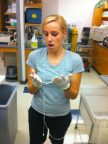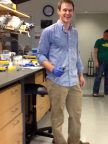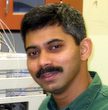Student Alumni
This page is sparsely maintained and only students who have graduated since mid-2014 are listed. If you are a student alum and would like to be listed, please fill in this form.
Student Alumni
Graduate Student, Cone laboratory, Molecular Physiology & Biophysics
My research project is focused on advancing our understanding of the molecular and kinetic mechanisms of energy maintenance by elucidating if and when MC4R induced Kir7.1 signaling is required for regulation of food intake and energy expenditure. We believe MC4R functions as a rheostat of energy maintenance by utilizing both tissue specific Gαs and Kir7.1 signaling modalities as well as unique kinetic aspects of these modalities. I am using an in vivo modeling system to test this hypothesis.
: 8435 MRB IV
- : erica.j.pruett@Vanderbilt.Edu
- : (615) 936-8144
Alumna Graduate Student, Terunaga Nakagawa lab, Molecular Physiology and Biophysics
AMPA receptors (AMPARs) are ligand-gated cation channels whose appropriate activity and regulation are integral to most central nervous system function. They mediate the majority of excitatory neurotransmission and their dysregulation has been implicated in many cognitive disorders. My research focuses on the molecular details of auxiliary subunit interactions with the AMPAR. Using biochemical and structural biology techniques, we hope to illuminate the molecular basis of interaction between these two proteins and how that relates to the auxiliary subunit’s modulation of AMPAR in vivo.
: 766 RRB (MRB I)
Graduate Student, O'Brien lab, Molecular Physiology & Biophysics
I work in Richard O’Brien’s laboratory and I study glucocorticoid regulation of G6pc2 expression in islet β cells.
: 8415 MRB IV
- : kayla.boortz@Vanderbilt.Edu
- : (615) 936-1629
Graduate Student, O'Brien laboratory, Molecular Physiology & Biophysics
Elevated fasting blood glucose (FBG) levels have been associated with an increased risk of type 2 diabetes (T2D) development and cardiovascular-associated mortality (CAM). Genome-wide association studies (GWAS) have identified SNPs in G6PC2 associated with FBG. G6PC2 is an isoform of the glucose-6-phosphatase catalytic subunit expressed in pancreatic islet beta cells. Deletion of G6pc2 in mice results in reduced FBG, consistent with the human GWAS data, and islets from these mice have enhanced glucose-stimulated insulin secretion (GSIS) at sub-maximal glucose concentrations. I am using mouse models to explore the function of G6pc2 in islet beta cells and its potential as a therapeutic target for the prevention of T2D and CAM.
Graduate Student, Hong laboratory, Molecular Physiology & Biophysics
Titin, the largest known protein, is indispensable for the structural integrity and function of the cardiac sarcomere. Yet, how such a massive ~3 mDa structural protein is maintained within the highly ordered sarcomere complex, while under continuously alternating tension, is unknown. My thesis focuses on elucidating the mechanisms mediating sarcomere homeostasis in human induced pluripotent stem cell-derived cardiomyocytes. Using CRISPR/Cas9 gene editing, I generated a novel model in which I can directly visualize sarcomeric titin in order to address fundamental questions regarding titin turnover, which is critical for sarcomere homeostasis.
Graduate Student, John Penn Laboratory, Molecular Physiology & Biophysics
I am currently studying inflammation in diabetic retinopathy in Dr. John S. Penn‘s Laboratory.
Graduate Student, Maureen Gannon laboratory, Molecular Physiology & Biophysics
Prostaglandins are important modulators of an array of physiologic functions including insulin secretion and systemic inflammation. In the Gannon lab, I focus on the specific roles of the prostaglandin E2 receptors EP3 and EP4 and how they regulate processes involved in β-cell mass expansion. I am using pharmacological tools to examine the effects of EP3 and EP4 signaling in β-cell proliferation and β-cell survival in isolated mouse and human islets. I am also studying the effects of an EP3 antagonist and an EP4 agonist on β-cell proliferation and β-cell survival in the db/db mouse model of type 2 diabetes.
: 7425C MRB IV
- : bethany.a.carboneau@Vanderbilt.Edu
- : (615) 936-2676
Graduate Student, Roland Stein Laboratory, Molecular Physiology & Biophysics
: 723 Light Hall
- : elizabeth.conrad@vanderbilt.edu
Graduate Student, Kenworthy Lab, Molecular Physiology & Biophysics
In the Kenworthy lab, my project focuses on understanding the role of Cav-1 mutants in the pathogenesis of pulmonary arterial hypertension.
: 718 Light Hall
- : courtney.a.copeland@vanderbilt.edu
- : (615) 322-6615
Graduate Student, Madhur Lab
I study the role of interleukin-21(IL-21) in hypertension associated end-organ damage and dysfunction using an IL-21 global knockout mouse. I am looking at the presence and effector function of IL-21 producing cells in Angiotensin II induced experimental hypertension.
: P410 MRB IV
- : bethany.l.dale@vanderbilt.edu
Graduate Student, Wikswo laboratory, Molecular Physiology & Biophysics
I am a graduate student in the Wikswo lab studying the role of amino acids in cardiac ischemia and hypoxia.
Graduate Student, David Piston's laboratory 2014, Molecular Physiology & Biophysics
Postdoctoral Fellow, Benjamin White & Hari Shroff at the NIMH and NIBIB
Graduate Student, Gannon Lab
A mother’s diet and metabolic status during gestation has been shown to affect her offspring’s risk of developing metabolic disease later in life. In the Gannon Lab, I study the mediators of this increased disease risk using two animal models of maternal high fat diet during pregnancy. In a collaboration with multiple labs across the country, I obtain pancreata from non-human primates exposed to high fat diet in utero. Pancreatic endocrine cell mass, structure, and function are currently being investigated. In a mouse model, I study the effects of maternal high fat diet on the epigenetic profile of pancreatic beta cells in the offspring. Together, these studies will enhance our understanding of how high fat diet during pregnancy predisposes offspring to develop metabolic disease.
Graduate Student, Peter Weil laboratory, Molecular Physiology & Biophysics
Graduate Student, Ron Emeson Laboratory, Molecular Physiology & Biophysics
In Ron Emeson‘s lab, I am characterizing the physiological impact of Kv1.1 RNA editing in mice.
: 8148 MRB III
Nashville, - 37232- : elizabeth.a.ferrick@Vanderbilt.Edu
- : (615) 936-1687
Graduate Student, Penn laboratory, Molecular Physiology & Biophysics
I research and create novel nanoparticles for molecularly targeted imaging of the eye. My project involves using gold nanorods as exogenous contrast agents in the eye that are compatible with optical coherence tomography systems. My research includes the construction of gold nanorods and their modification for stability and biocompatibility. I collaborate with researchers outside my lab to perform work related to photothermal optical coherence tomography. Additionally, my research focuses on methods of drug delivery to the eye. As this is imaging research, I use a variety of imaging modalities relevant to in vivo imaging of the eye, notably optical coherence tomography.
Graduate Student, Jacobson laboratory, Molecular Physiology & Biophysics
Our lab studies the function of potassium channels in electrically excitable endocrine cells within the pancreas. We are particularly interested in the β-cell specific potassium channel, TALK-1. TALK-1 is the most abundant potassium channel in the β-cell, and a polymorphism within TALK-1 has been associated with an increased risk for Type-2 diabetes. Our lab has previously shown that TALK-1 channels regulate the β-cells ability to release insulin in response to glucose. My work focuses on characterizing this regulation so that we can better understand the function that the channel plays in diabetes.
MD PhD Student, Al Powers laboratory, Molecular Physiology & Biophysics
Recent observations have challenged long held concepts in the pathophysiology of type 1 diabetes. By implementing an integrative approach to study both the native pancreas and isolated islets from the same human donor, I work to characterize the function and morphology of T1D pancreatic islets using in vitro and in vivo functional studies and immunohistochemistry. My primary project focuses on the glucagon-producing alpha cells in the T1D islet and identifying the mechanisms behind disordered glucagon secretion in T1D.
MD PhD Student, Winder laboratory, Molecular Physiology & Biophysics
Drug dependent patients trying to maintain abstinence often relapse to their chosen of drug of abuse, with many citing stress as an antecedent to use and a lack of effective treatment to control the urge to use. Guanfacine is an α2A-adrenergic receptor agonist that targets receptors for the brain stress neurotransmitter norepinephrine and has been used in both preclinical and clinical trials for addiction, often showing positive results such as reduced craving but not producing changes in ultimate rates of relapse. We hypothesize that the ineffectiveness on relapse is due to competition among the myriad effects of this drug and aim to study a non-canonical neuronal activating effect in the bed nucleus of the stria terminalis, an area of the brain known to be implicated in both stress and addiction disorders, through the complementary use of whole cell electrophysiology and neuroanatomical methods in the hopes that uncovering the mechanism underlying this effect will aid in future treatment of patients dependent on drugs of abuse.
: 754 PRB
- : nicholas.a.harris@Vanderbilt.Edu
- : (615) 714-9631
Graduate Student, Alyssa Hasty laboratory, Molecular Physiology & Biophysics
I work in Alyssa Hasty‘s laboratory where we study inflammation and obesity.
MD PhD Student, Hasty laboratory, Molecular Physiology & Biophysics
I am studying the role of macrophages in maintaining iron homeostasis in adipose tissue. Specifically, we have identified a subset of resident macrophages that compensate for excess iron in the tissue. We are currently interested in depleting this population of macrophages in order to assess their importance in maintaining the health of adipocytes. In future studies we will address the importance of iron handling by macrophages in obesity, and the temporal distribution of iron in adipose tissue and liver tissues.
: 813 Light Hall
- : merla.j.hubler@vanderbilt.edu
Graduate Student, Powers laboratory, Molecular Physiology & Biophysics
My thesis in the Powers laboratory addresses basic questions of diabetes pathology, specifically (1) the functional consequences of chronic hyperglycemia on human pancreatic islets in vivo, and (2) the effects of ErbB growth factors on islet growth and function
Defended Dissertation in the Neuert Laboratory on October 6, 2023, Molecular Physiology and Biophysics
: 813 Light Hall
Graduate Student, Gannon laboratory, Molecular Physiology & Biophysics
I am interested in understanding the role of the transcription factor Oc1 (Onecut1) in pancreas development and disease. Oc1 is essential for development of the endocrine pancreas, so I am investigating its interaction its cofactor Pdx1 in that role. I have thus far determined that proper dosage of both Oc1 and Pdx1 is necessary for endocrine cell differentiation and that defects established during development persist into adulthood. I am further interested in identifying the direct targets of Oc1 during pancreas development since so little is known about its direct regulatory role.
: 7435 MRB IV
MD PhD Student, Cone laboratory, Molecular Physiology & Biophysics
In the Cone lab, I study the pathophysiology associated with deletion of the MC4R, the most common monogenetic obesity syndrome in man (1/5000 allele frequency). Using the mouse as a model organism, I am characterizing the cardiovascular, metabolic and energetic consequences that result from MC4R deletion. Observations from my research have furthered the need to identify and monitor patients with this distinct obesity syndrome.
More broadly, my research interests include: energy metabolism, mitochondrial physiology, cardiovascular pathophysiology, pharmicogenomics, and gene environment interactions.
: 8435 MRB IV
- : michael.j.litt@Vanderbilt.Edu
Graduate Student, Harrison laboratory, Molecular Physiology & Biophysics
In the past 20 years, two new mechanisms of hypertension have been defined: one is oxidative injury and the second is inflammation. Our lab has shown that dendritic cells (DCs) from hypertensive mice accumulate isolevuglandins that adduct to proteins and promote T cell activation. In hypertension, the endothelium is activated to produce reactive oxygen species and to express adhesion molecules and chemokines that attract inflammatory cells. In my project, we hypothesized that human endothelial cells exposed to mechanical stretch will promote conversion of human monocytes into activated DCs. Therefore, I study this conversion when monocytes co-cultured with human aortic endothelial cells exposed to either normal cyclical stretch (5%) or hypertensive cyclical stretch (10%) using the Flexcell® Tension System. I also study the different signaling molecules that could potentially be facilitating this process in hopes of understanding the mechanism of action.
Graduate Student, McGuinness laboratory, Molecular Physiology & Biophysics
In the McGuinness lab, my long-term research objective involves elucidating the mechanisms whereby neuroendocrine function can be regulated by alterations in the inflammatory environment.
Graduate Student, Colbran laboratory, Molecular Physiology & Biophysics
Calcium/calmodulin-dependent kinase II (CaMKII) is a highly abundant serine/threonine kinase in the brain. Direct interactions between activated CaMKII and its substrates play a number of important roles within the cell such as feedback regulation of channels/receptors, and normal synaptic plasticity. Relatively few CaMKII-associated proteins are known to preferentially interact with inactive CaMKII, and their functional roles are poorly understood. Moreover, molecular mechanisms underlying the coupling of CaMKII to the G-protein coupled receptors (GPCRs) that stimulate the release of intracellular calcium are poorly characterized. An interaction between inactive CaMKII and the metabotropic glutamate receptor 5 (a Gq-coupled GPCR) was recently reported. I am currently investigating how CaMKII interactions with mGlu5 can change mGlu5 signaling. Understanding the physiological importance of this interaction may lead to novel treatments of neurological disorders linked to dysfunction of mGlu5 such as Parkinson’s Disease, addiction, schizophrenia, and autism spectrum disorder.
: 724 Robinson Research Building
- : christian.r.marks@Vanderbilt.Edu
Graduate Student, Stein laboratory, Molecular Physiology & Biophysics
In the Stein lab, I work on identifying co-regulators of Pdx-1 and their regulation of critical β-cell genes.
: 723 Light Hall
Graduate Student, Weil Laboratory, Molecular Physiology & Biophysics
RNA Polymerase II transcriptional activation contributes importantly to the regulation of gene expression by controlling mRNA biosynthesis. A central driving force of the activation process is provided by the concerted action of a DNA-binding transfactor and at least one coactivator. I am interested in defining the transfactor-coactivator interactions required for activation. The specific goal of my current work in the Weil lab is to determine the specific domains the Rap1 transcriptional activator uses to interact with the general transcription factor TFIID to drive activation of the budding yeast S. cerevisiae ribosomal protein genes. I combine genetic, biochemical, and biophysical approaches to accomplish this goal.
: 742 RRB
- : amanda.meyer@Vanderbilt.Edu
- : (615) 322-7008
Graduate Student, Molecular Physiology & Biophysics
I work in Hassane Mchaourab‘s lab on the structure and function of small heat shock proteins, particularly their function in the lens.
: 741 Light Hall
- : sanjay.mishra@Vanderbilt.Edu
Defended Dissertation in the Jacobson Laboratory on August 30, 2023, Molecular Physiology and Biophysics
Graduate Student, Madhur laboratory, Molecular Physiology & Biophysics
My thesis project in Dr. Harrison’s laboratory is centered on the role of T cells in hypertension.
MD PhD Student, Stafford lab, Molecular Physiology & Biophysics
: 7445 MRB IV
Graduate Student, Colbran lab, Molecular Physiology & Biophysics
Brain function relies on the formation and stabilization of synapses, and many neurological disorders are associated with disruptions in synaptic signaling. Scaffolding proteins play a critical role in maintaining spine morphology and bringing receptors and ion channels in close proximity to their downstream signaling molecules. In the Colbran lab, I study protein-protein interactions between CaMKII and scaffolds in the postsynaptic spines of neurons, and how they regulate downstream signaling. I am also interested in how neurons signal from the synapse to the nucleus in order to initiate gene transcription, an important process in learning and memory.
BA, DePauw University
: 724 RRB
- : tyler.perfitt@vanderbilt.edu
Graduate student and Postdoctoral Fellow with James May 2008-2014, Michigan State University
Currently: Industrial Postdoctoral Fellow
Research Assistant Professor, Molecular Physiology and Biophysics
Graduate Student, Piston laboratory, Molecular Physiology & Biophysics
: 747 Light Hall
- : chris.reissaus@vanderbilt.edu
Graduate Student, Powers laboratory, Molecular Physiology & Biophysics
In the Powers Lab, I am investigating the role of pancreatic endothelial cell populations in the islet microenvironment, by determining their role in macrophage recruitment and beta cell regeneration. I am also isolating subpopulations of human islet cells, ultimately characterizing how gene expression varies during developmental stages and in disease states.
: 8435 MRB IV
Graduate Student, Vickers laboratory, Molecular Physiology & Biophysics
Communication by HDL-miRNAs in Type 2 Diabetes
MicroRNAs (miRNAs) are small non-coding RNAs that post-transcriptionally repress gene expression and are found in both cells and extracellular fluids, including plasma. Extracellular miRNAs are protected from circulating nucleases through their association with lipid and protein carriers, specifically exosomes and lipoproteins.. Currently, I am studying the role of high-density lipoproteins (HDL)-miRNAs as cell-to-cell messengers in a novel endocrine-like communication pathway within Type 2 diabetes. We found that many of the most abundant miRNAs on HDL are also enriched in insulin-producing β-cells in the islets of Langerhans. Additionally, we found that the miRNA signature on HDL is significantly altered in rat models of Type 2 diabetes; therefore, the goal of my project is to investigate the molecular mechanisms by which the β-cell-originating miRNAs control gene expression in distal tissues and how this pathway regulates systemic lipid and glucose metabolism. Using high-throughput genomics, I aim to decode and control miRNA intercellular communication to better understand and treat type 2 diabetes, including developing biomarkers to predict pre-diabetes.
: 358 RRB
Graduate Student, O'Brien laboratory, Molecular Physiology & Biophysics
The prevalence type 2 diabetes (T2D) continues to increase worldwide. Multiple SNPs associated with altered risk of T2D have been identified through genome wide association studies including rs13266634 in the SLC30A8 locus, which encodes zinc transporter 8 (ZnT8). In addition, rare mutations resulting in SLC30A8 haploinsufficiency are protective against T2D. Using several mouse models, we are investigating the role that ZnT8 plays in beta cell function and the potential of ZnT8 as a therapeutic target for T2D.
: 8415 MRB IV
Defended Dissertation in the Gannon Laboratory on July 17, 2023, Molecular Physiology & Biophysics
Graduate Student, Wasserman laboratory, Molecular Physiology & Biophysics
Liver is a primary site of macronutrient metabolism. Obesity linked diseases of the liver such as nonalcoholic fatty liver disease (NAFLD) and nonalcoholic steatohepatitis (NASH) result in ECM expansion, defective hormonal responses, and disrupted transcriptional networks. Integrin receptors and their immediate post-receptor pathways convert sensory inputs from the ECM to biochemical processes within the cell. Altered expression of several integrin signaling components accompanies the metabolic dysregulation that occurs in high fat (HF)-fed mice. The mechanisms linking ECM expansion and integrin signaling to metabolic disease are a primary focus of our lab. My research utilizes hepatocyte specific knockout of several integrin signaling components (e.g. integrin α5, integrin β1, and Integrin-linked kinase) in mice to fully characterize these pathways and their involvement in pathologic responses of the liver to high fat feeding.
: 823 Light Hall
- : elijah.trefts@vanderbilt.edu
Research Fellow / Piston Lab, Molecular Physiology and Biophysics
Research Interest: I am currently investigating the function of dopamine in the pancreatic islets with the goal of understanding how observed dopaminergic feedback regulates glucose stimulated insulin secretion.
: 747 Light Hall
2215 Garland Avenue
Nashville, - 37232- : alessandro.ustione@vanderbilt.edu
Graduate Student, Neuert Laboratory, Molecular Physiology & Biophysics
In the Neuert Lab, I study long noncoding RNAs (lncRNAs), a class of non-protein coding transcripts that represents an emerging, previously unrecognized layer of gene regulation. LncRNAs have been shown to mediate important biological processes ranging from cell cycle progression and cellular reprogramming to dosage compensation in mammalian development, but their mechanisms of action remain poorly understood. I work toward addressing these fundamental knowledge gaps.
Graduate Student, Jacobson laboratory, Molecular Physiology & Biophysics
The deterioration of pancreatic islet function is a hallmark of type 2 diabetes mellitus (T2DM). In the Jacobson lab, I study the physiological functions of an islet potassium channel, TALK-1. TALK-1 is the most transcriptionally abundant potassium channel in insulin-secreting β-cells, and polymorphisms in TALK-1 are associated with an increased susceptibility for T2DM. However, the molecular mechanisms underlying TALK-1’s contributions to T2DM pathogenesis remain unclear. Using a variety of experimental approaches, including electrophysiology, calcium imaging, hormone secretion, and mouse models, we have recently found that TALK-1 channels regulate islet calcium homeostasis and insulin secretion. These findings suggest that TALK-1 could serve as a therapeutic target in T2DM.
: 7415 MRB IV
- : nicholas.c.vierra@Vanderbilt.Edu
Graduate Student, Powers laboratory, Molecular Physiology & Biophysics
I am an MD/PhD student who joined the lab of Al Powers and Marcela Brissova in 2016. I am originally from Kansas City and did my undergraduate work at Washington University in St. Louis. In undergrad, I worked on research projects that used novel chemical techniques to elucidate protein structure and function. In the Powers and Brissova lab, I am interested in mechanisms of human islet function and dysfunction and use unique models including in vivo transplantation of human islets and dispersion and reaggregation of islet cells to form pseudoislets. I am also characterizing the functional, morphologic, and transcriptional profiles of islets, sorted α and β cells, and pancreatic tissue from individuals with type 2 diabetes and using viral manipulation in the pseudoislet system to understand mechanisms of islet dysfunction in type 2 diabetes. I plan to pursue a career as a physician-scientist in pediatric endocrinology upon his return to medical school.
Graduate Student, Vickers laboratory, Molecular Physiology & Biophysics
Extracellular microRNAs have been identified in plasma, and our laboratory has identified these extracellular microRNAs are carried by lipoproteins including high-density lipoprotein (HDL). The goal of our laboratory is to characterize the role of these extracellular microRNAs, particularly to elucidate whether extracellular microRNAs may function as a novel cell-to-cell communication pathway. Within cells, microRNAs are small non-coding RNAs that post-transcriptionally regulate gene expression. Specifically, I study the myeloid-derived microRNA, miR-223, to understand to what tissue and cell types receive microRNA-223 after being exported from myeloid cells. To do this, I utilize bone marrow transplants between wild-type and miR-223 knockout mice to restore or deplete the myeloid (miR-223 donor cell) population. After restoring or depleting the myeloid population (miR-223 donor cell) I examine variety of tissue types and pure cell isolations to map out the delivery of extracellular miR-223 in vivo. My second project focuses on the role of endothelial microRNAs in the progression of Chronic Kidney Disease-associated atherosclerosis. I have found that complexing two microRNA inhibitors to HDL, allows me to effectively reduce endothelial microRNA levels. The decreased microRNA levels result in a dramatic reduction in atherosclerosis in vivo, which may be mediated through altered FAM220a regulation of STAT3 activation causing less inflammation.
: 358 PRB
Graduate Student, Wasserman laboratory, Molecular Physiology & Biophysics
: 823 Light Hall
Graduate Student, Wasserman laboratory, Molecular Physiology & Biophysics
Impaired insulin-stimulated muscle glucose uptake is a hallmark of insulin resistance and Type 2 diabetes. Before insulin can stimulate the muscle to take up glucose, it must first cross the endothelial barrier that separates the plasma from the interstitial fluid that bathes myocytes. I have developed an intravital microscopy technique which allows us to directly visualize and quantitate the trans-endothelial efflux of insulin in skeletal muscle. I am using this technique to 1) determine the mechanism by which insulin crosses the endothelium (i.e. receptor-mediated transport or passive diffusion) and 2) determine if impaired trans-endothelial movement of insulin may contribute to muscle insulin resistance.
: 823 Light Hall
Graduate Student, Hawiger laboratory, Molecular Physiology & Biophysics
















































